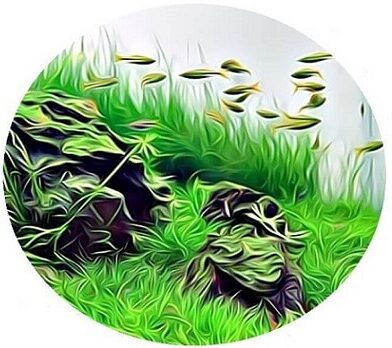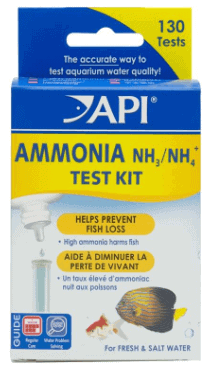Freshwater Aquarium Water Parameters
One of the most critical tasks that you must do to keep your aquarium clean and in good shape for your plants, fish, snails, and shrimps is to take care of your aquarium water parameters.
Think about this: your fish stays all the time in your aquarium water. It’s like our oxygen! That’s how important the quality of your tank water is for their health.
Taking care of your freshwater aquarium Water Parameters means:
- You need to know your aquarium water in normal circumstances so you can buy the right fish and plants.
- Knowing your aquarium water in normal circumstances also helps you see when something is wrong and needs your attention and how much worse it is.
- Monitor and adjust your aquarium water from time to time and when needed.
- Check the water you use to fill your tank to avoid significant variations that could cause health issues.
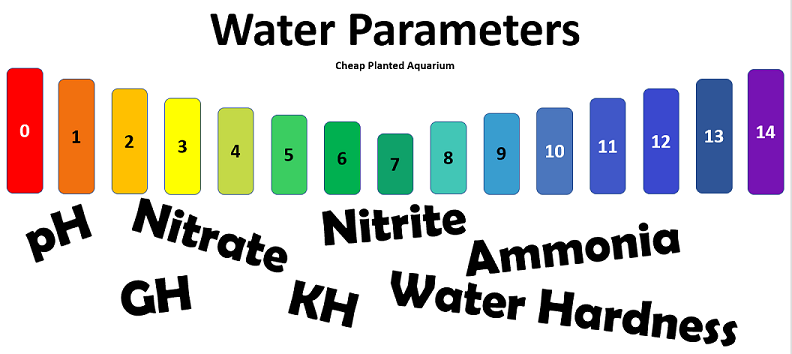
What is the meaning of water parameters?
In the aquarium world, there are different types of water in the same way we have different types of water in natural environments, such as high pH, low pH, hard water, soft water, dark water, etc.
For example, the water from the Amazon River in Brazil is very dark and Acid due to a lot of dissolved organic material.
The water from Florida (United States) is very hard due to the soil composition of this region.
The water from the Rift Valley lakes in Africa, where the African Cichlids are from, is very alkaline and hard.
Let’s talk about some of the most common water parameters
Table of Content
Water pH
The Water pH (potential hydrogen) determines the water’s degree of acidity or alkalinity.
Consider pH 7.0 as Neutral. Values below 7.0 are acidic and, above that, alkaline.
PH values are logarithmic! When we go from pH 7 to 8, despite being a low-value change (one unit), we are talking about powers of ten. That is, pH 8 is 10x more alkaline than pH 7, pH 9 is 100x more alkaline than 7, and so on, so a 1-point change in pH can be a considerable variation
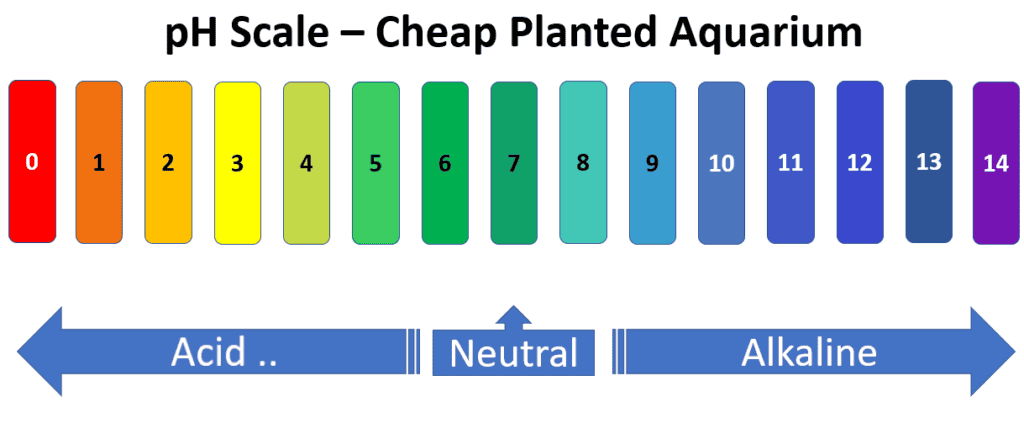
It is vital to keep the pH in line with the intended fish and regularly check it as, in general, there is a tendency for the pH to fall or increase gradually due to the rocks you are using, fish poop and urine, etc.
How frequently should I check my aquarium’s pH?
If your aquarium is new and you just finished cycling it (learn more about cycling it here), you must monitor your water pH three times per week.
Two months after the cycling process is completed, if you don’t see significant variations (more than one pH point up or down), you can start to measure it twice per week or whenever you add new rocks, fish, or decorations or after you do water changes or refill your tank’s water.
After three months, you can start monitoring your water pH once a month or whenever you add new rocks or change something relevant in your tank.
How to measure my aquarium’s pH?
There are at least three ways to measure your water’s pH.
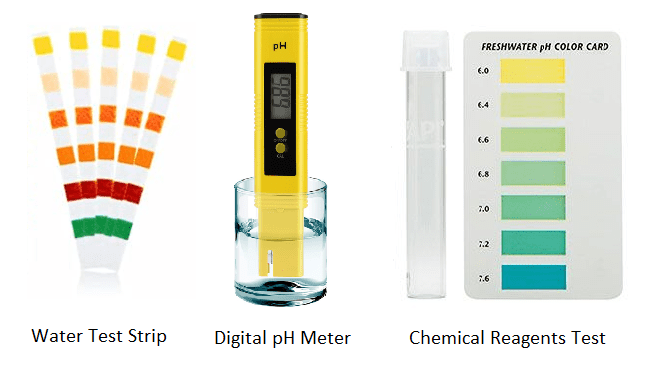
I recommend you start with the “Water Test kit,” using Chemical Reagents, as they are cheap, easy to use, don’t require maintenance, and their accuracy is good enough. Even if you are Color-blind, stay with me as I have a suggestion to help you.
Water Test Kit using Chemical Reagents
This is the most common way to measure your aquarium water pH. It is a cheap method, easy to use, doesn’t require maintenance, and its accuracy is good enough.
As I have said before, this is the method I recommend.
API is the most popular choice and the one I have been using for years.
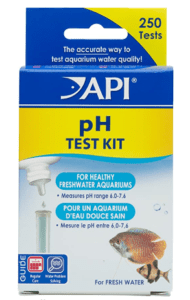
When you Water Test Kits with chemical reagents, you will need to compare the color of the test result with a colored table.
If you are Color-blind and have difficulty seeing these water test results as they use colors, jump to this topic where I give you a suggestion on how to handle it.
Digital pH Meter
Another option to measure your aquarium water pH is the digital pH Meter.
They are cheap, easy to use, and easier to read the result when compared with the other two methods.
The downside, however, is that you need to calibrate them frequently (watch this video to have an idea about how the calibration works), and they need to be replaced every 3 to 6 months, depending on the model and brand.
I have a dedicated article covering these devices. How to clean, store, calibrate and use them, and know when to replace them.
Here you have a short video on how to operate a Digital pH Meter so you can have an idea about how they work.
This is the brand and model I have been using for years, and recommend you.
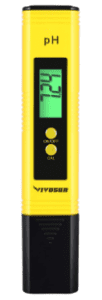
Using Water Test Strips
This method is cheap and easy to use, but I don’t like it because it is hard to read their results.
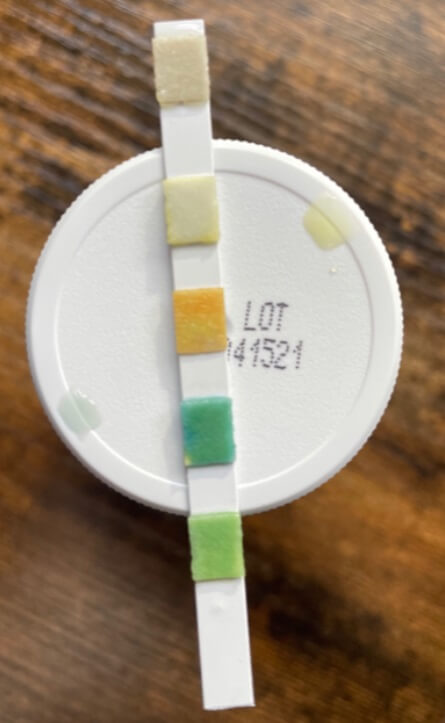
How to raise your aquarium pH
As this article was written focusing on the different types of water parameters, I will not go deep and explain all the different ways to raise your aquarium’s pH.
Still, as explained in the Aquarium co-op website (here), “”we use 1 pound of crushed coral sprinkled into the gravel for each 10 gallons of water to raise the pH slowly over time. This needs to be replaced from time to time, typically 6 to 18 months depending on how acidic the starting water is. If you wish to add crushed coral to your filter, know that it’ll raise the pH faster, but also it’ll run its course faster.””
How to lower your aquarium pH
I wrote this article focusing on the different types of water parameters and measurements, so I will not go deep on how lower your aquarium’s pH, but if you are looking for this information, this is what Aquarium Co-Op says (here): “”unfortunately that is a much harder task. We recommend using an R/O filter if you absolutely must lower it. An alternative would be to use a planted tank and stop changing water. This will lead to acidification of the water over time. When the water gets to the level you’d like, you can then do very small water changes periodically to maintain that level and safe parameters for your fish.””
Ammonia
Fish, snails, shrimps, and other animals poop and urinate in the water, and this residue becomes Ammonia, which is toxic.
Measuring your aquarium’s Ammonia is extremely important, and you must work to keep it always zero.
Even 0.25 ppm or 0.5 ppm of Ammonia are toxic. Read more details here.
If you give too much food to your fish, food detritus become Ammonia when they decompose in the water.
By the way, shrimps are especially sensitive to Ammonia.
If you suspect that your fish are poisoned with ammonia, see the symptoms here.
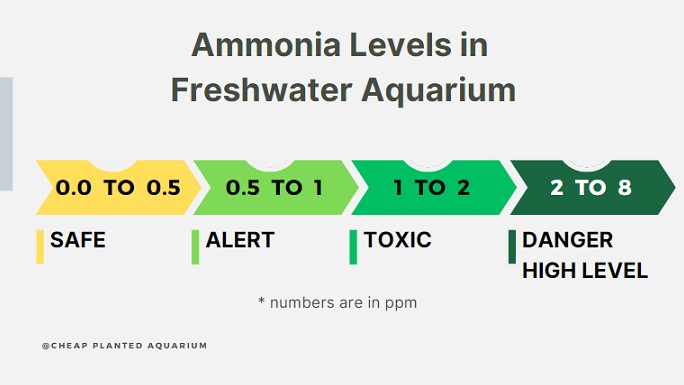
Ammonia Test for Fish Tank
The only way to test the Ammonia Level of your fish tank water is using a chemical test kit like this one from API.
If you are Color-blind and are have difficulty seeing these water test results as they use colors. Jump to this topic where I give you a suggestion on how to handle it.
How to Keep Your Ammonia under control
- Cycling your aquarium: this is a must! This process will prepare your tank to have enough good bacteria in your water filter and substrate to consume the Ammonia. It is the most important way to keep Ammonia under control. Read more here about cycling your aquarium using different methods and which is the best and fastest way.
- Do not overfeed your fish.
- Remove dead plants, fish, snails, or anything that could decompose in your water.
- Keep your aquarium clean. Replace and clean your filter media frequently.
- Add more plants to your tank (plants consume Ammonia).
- Keep up with your water changes routine.
How to reduce the aquarium ammonia levels
- Do a significant water change (35% to 50% of the water). Test the water you are using to refill to ensure it doesn’t have Ammonia.
- Use chemicals to neutralize Ammonia, like Seachem Prime
If you have an emergency and need to reduce your aquarium ammonia immediately, use Seachem Prime.
How frequently should I check my aquarium’s Ammonia?
If your aquarium is new and you just finished cycling it (learn more about cycling your aquarium fast here), you must monitor your water Ammonia three times per week.
Two months after the cycling process finishes, if you see that your Ammonia level is keeping close to zero consistently, you can start to measure it twice per week.
After three months, you can start monitoring it once a month.
Nitrite
When the biological filtration processes Ammonia, it becomes Nitrite in the so-called Nitrogen Cycle (learn more here)
Nitrite is less toxic than Ammonia but still toxic.
How to measure my aquarium water Nitrite levels
In addition to Ammonia, measuring Nitrite is also crucial.
You can measure your Nitrite using, for example, this kit.
How to Keep Your Nitrite levels under control
Nitrite comes from Ammonia, so the steps you would take to keep your Ammonia under control are also valid for Nitrite.
- Cycling your aquarium: again, this is a must. Those good bacteria created during the cycling will consume your aquarium’s Nitrite helping you to keep it under control. Read more here about cycling your aquarium using different methods and which is the best and fastest way.
- Do not overfeed your fish.
- Remove dead plants, fish, snails, or anything that could decompose in your water.
- Keep your aquarium clean, replace and clean your filter media frequently.
- Keep up with your water changes routine.
How to fast reduce your nitrite levels
If you have an emergency and need to reduce your Nitrite level immediately, change 25% to 50% of your aquarium water
Nitrate
Nitrate is the third piece of the Nitrogen Cycle (more here) as bacteria transform Ammonia into Nitrite and Nitrite into Nitrate.
Nitrate is much less toxic than Ammonia and Nitrite.
Plants and algae consume it. Its control is essential for algae control and plant growth, especially in planted aquariums.
I like to use this kit to measure nitrates.
General Hardness (GH)
GH is a water hardness property essential for your fish and invertebrate’s development, organ function, and breeding.
When measuring your water’s GH you are measuring the amount of calcium (Ca++) and magnesium (Mg++) in the water.
Generally, 3 to 15 dGH is recommended, but if you are working on a planted tank, 3 to 5 degrees dGH is a reasonable level.
I have a complete guide on How to Measure, Increase or Reduce your Aquarium water General Hardness here .
This is the test kit I have been using to measure my aquarium water general hardness.
Total Alkalinity (KH)
KH is a water property defined by the quantity of bicarbonates, carbonates, and hydroxides dissolved in your aquarium water.
A good KH level is essential to keep your aquarium’s pH stable (due to its capacity to neutralize acid components).
For example, if you throw an Acid substance into your tank, these bicarbonates, carbonates, and hydroxides will react with it, and will neutralize an amount of the acid component avoiding the acidification of your aquarium water.
If your KH is too low, you could have a fast pH variation (pH crash) and cause fish dead.
A good level to keep is between 4 and 12 degrees.
I have a complete guide on How to Measure, Increase or Reduce your Aquarium water KH here.
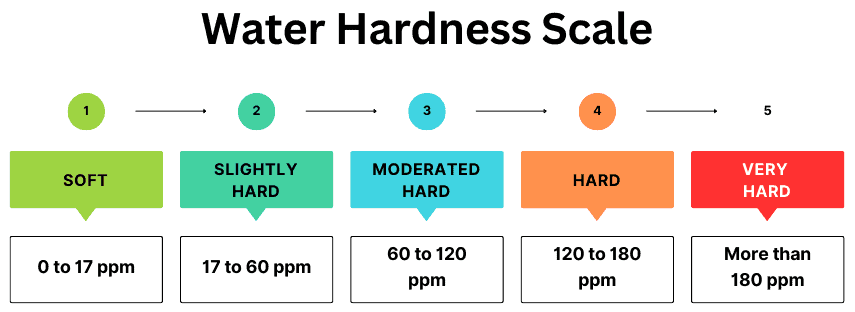
Chlorine
Our Tap water (water from your hose) has a lot of Chlorine. It is added to the water to kill germs, bacteria, viruses, and other microbes. You can find out more about Water Chlorination in this article.
Chlorine is very toxic to fish and other livestock. Concentrations of as little as 0.2 to 0.3 ppm kill fish rapidly.
You can use many products to remove Chlorine from your tap water or the water you use to refill your tank.
This is one that I like and have been using.
Planted Aquarium Water Parameters
Planted Aquariums are tanks with natural plants.
You can have Low-Tech Planted Tanks and High-Tech Planted Tanks. Learn more about them here.
There are many reasons to have live plants in your tank, for example, to filter out CO2, Ammonia, and Nitrate and to give hidden places for your fish, reducing their stress.
These are the ideal water parameters for your planted aquarium.
- pH: between 5.5 and 7.5 (avoid the extremes)
- GH: from 3 to 5 dGH (that is 53 to 89.5 ppm)
- KH: from 4 to 8 dKH (that is 70 to 140 ppm)
- Nitrate: from 1 to 5 ppm (that is between 10 and 30 mg/L NO3)
- PO4: about 0.5 ppm
Note: plants are usually less sensitive to water parameters than fish, snails, and shrimps.
There are two types of planted aquariums:
Are aquarium test strips accurate?
Aquarium test strips provide a certain degree of accuracy, like other water test kits. The idea here is to give you a direction. To tell you how your water is. I personally don’t like them.
I am color blind and now?
I have seen people asking in many Fish Keepers forums and discussion groups how to read chemical test kits if they are color blind. I have seen many suggestions for this Mobile Phone App: “Color Blind Pal“. It is available for Android and Apple Devices.
If you have some other suggestion, please let me know and I will update this article to help as many people as possible.
If you have other suggestions, please let me know, and I will update this article to help as many people as possible.
If you use this App and if you like it or not, please let me know too !!
What is next
I suggest you to have a look in my “Water Hardness” article to learn about KH, GH, Water Hardness and how to raise or reduce them and much more. Click here.
My friend from aquascape.blog has a good article here. This article is also very good.
I hope you liked this article. Good Luck!
